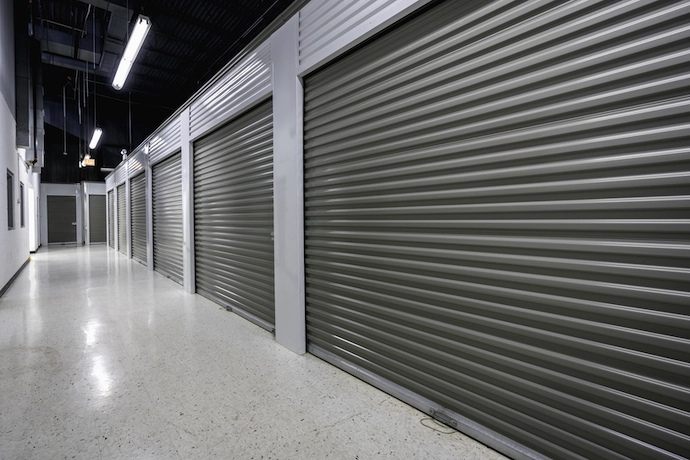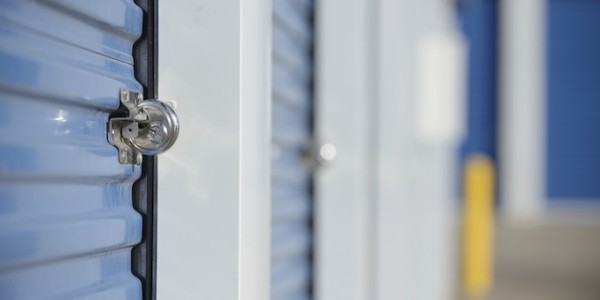What’s covered in this article – click on a link to learn more:
- What is climate-controlled storage?
- Air cooled vs climate-controlled
- Heated vs climate-controlled
- Is climate-controlled storage necessary?
- Climate-controlled benefits
- Items that need climate-controlled storage
- How much does climate-controlled storage cost?
- Alternatives to climate-controlled storage
- Items that don’t need climate-controlled storage
Savvy customers know that not all storage units are created equal. One big differentiator is whether the unit offers temperature-controlled storage. Depending on what you need to store, this is a crucial detail to lock down before you make any final decisions about where to store your belongings. If you’re in the market for a storage unit, read on for all the information you need to make the right choice about climate-controlled storage.
Ensuring moderate humidity and temperature levels in storage units is key against warping, discoloration, as well as mold and mildew growth. High humidity and heat can make photos curl and fade rapidly, and they can make stringed instruments and wooden furniture swell and warp.
Dry, cold air also damages the wood, causing it to shrink and crack, while moisture and condensation are quite the enemies when it comes to all types of musical instruments, metal items, fabrics and electronics.
What Is Climate-Controlled Storage?
Climate-controlled storage ensures your stored items are being kept within a set temperature and humidity range throughout the year. Most climate-controlled storage units are set to keep the temperature between 50 and 80 degrees using HVAC systems. As humidity levels are a key factor in preserving the integrity of certain belongings, climate-controlled storage facilities rely on dehumidifiers to keep humidity levels between 45% and 65%. Many storage facilities are also equipped with air filtration systems, which can remove allergens, dust, and other pollutants from the air. Regulation of air temperature and humidity levels inside storage units gives customers the peace of mind that their items will not experience warping, mold, mildew or other types of climate-related damage.
What is the difference between air-cooled and climate-controlled storage?
Climate-controlled storage facilities usually ensure heating during winter and cooling during summer. Air-cooled storage can be enough in hot regions, but make sure that what you get is not just temperature-controlled storage, as humidity levels are also important when storing sensitive items.
What is the difference between climate-control and heated storage units?
Heated storage units keep your items warm during winter, but provide no protection against extreme temperatures in the hot summer months. If what you store does not require air conditioning or if the temperature inside the storage facility never gets worryingly high, opting for heated storage instead of climate control might be a somewhat cheaper storage option.
Is climate-controlled storage necessary?
It depends. Do you plan to store your grandfather’s antique violin year-round at a facility in northern Michigan? Then yes, you need climate control! An item like this will be negatively affected by extreme cold, temperature fluctuations, and high humidity.
Geographic location and local climate play a major role in determining how your items should be stored. You may be able to skip temperature-controlled storage in mild climates with low humidity. However, in harsher, wetter climates, you should think twice before storing goods in a non-temperature-controlled facility. Even on a relatively pleasant 80-degree day, inside a storage unit it will be much hotter than the outside temperature.
The length of time you need to store an item also impacts whether you need climate control. Erick Thorson, independent agent with World Insurance in Arizona who specializes in insuring self-storage facilities, has seen several examples of families that opted out of climate control when storing sensitive items like art between moves. Even during these short periods, damage was done. For this reason, Thorson says it’s always best to choose climate-controlled storage for delicate items. When considering which items to store, also keep in mind that long-term storage can increase the risk of harm in certain situations.
What are the benefits of climate-controlled storage?
Have you ever walked into a basement and immediately been hit with the musty smell of mildew? It’s an unpleasant experience to say the least, and even more upsetting if you can see what the mildew is growing on. In a humid, damp environment, mold and mildew can take up residence on a wide variety of surfaces. And trying to remove it is usually impossible. You should avoid storing anything of value, whether monetary or emotional, in areas that get hot and humid. The same can be said for areas that are subject to extreme cold. The condensation that can form under these circumstances is very destructive to computers and other electronics, among other items.
Protecting your goods against temperature fluctuations is absolutely essential when dealing with sensitive items. One way to maintain a stable temperature in a storage unit is with heated storage. Dry, cold air damages wood, causing it to shrink and crack, while moisture and condensation that can be the byproduct of cold can wreak havoc on all types of musical instruments, metal items, fabrics and electronics. Heated storage units keep your items warm during winter, but keep in mind that they provide no protection against extreme temperatures in the hot summer months.
Documents are one of the most common items kept in storage units, especially for small businesses. If this is the case for you, be particularly careful about humidity-related damage. Ensuring moderate humidity and temperature levels in storage units is key against discoloration and mold and mildew growth. High humidity and heat can also make documents and photos curl and fade rapidly.
A final benefit of a climate-controlled facility is the advanced security features they typically offer. These include surveillance cameras, storage unit alarms, and gated or keypad controlled access.
What Items Need Climate Control Storage?
Climate-controlled storage is highly recommended for sensitive items like:
- Artwork
- Musical instruments
- Vinyl records
- Family heirlooms
- Important documents
- Photos
- Collectibles
In addition to these, temperature control and humidity control are also important for
- Appliances and electronics
- Wood furniture
- Mattresses
- Books
- Candles
- Wine
- Fur and leather products
- Clothing and fabrics in general
Dry, cold air also damages the wood, causing it to shrink and crack, while moisture and condensation are quite the enemies when it comes to all types of musical instruments, metal items, fabrics and electronics.
Ensuring moderate humidity and temperature levels in storage units is key against warping, discoloration, as well as mold and mildew growth. High humidity and heat can make photos curl and fade rapidly, and they can make stringed instruments and wooden furniture swell and warp.
How much do climate-controlled storage units cost?
For reasons that you can probably understand if you’ve ever paid a heating bill in a cold climate, the cost of renting climate-controlled self-storage is more expensive than traditional options. How much more you pay depends on where you live and the unit size, just like heating a big house in Chicago costs more than a small one in North Carolina. You can predict a monthly cost that is 20-50 percent higher than standard units.
Another cost you need to consider is insurance. Thorson recommends additional coverage for all valuables.
“A lot of storage facilities offer basic insurance coverage, but it only covers damage from events like fires or natural disasters. So if you are storing things that have high monetary or sentimental value that you might want to consider additional coverage so that if something does happen, you are more adequately covered”
Erick Thorson, independent agent with World Insurance in Arizona
What are the alternatives to climate-controlled storage?
Non-climate-controlled storage is a valid option for a range of storage items. Some examples include holiday decor, patio furniture, garden and kitchen equipment, and clothing in sealed containers. If your storage needs are limited to these types of items, you may benefit from renting an outdoor storage unit with drive-up access.
Things that don’t need climate-controlled storage
Gardening equipment, water hoses, and outdoor furniture can withstand extreme temperatures and higher humidity levels without any issues, as it is in their nature to be used all year long regardless of weather conditions.
These items also don’t require climate-controlled storage:
- most sports equipment
- outdoor holiday decorations
- tools
- kitchen items
- cars and boats that are not antiques
Things that should never go in a storage unit
Whether climate-controlled or not, make sure you never put food, plants, or hazardous materials in a storage unit. For instance, avoid storing any corrosive, flammable, or explosive material such as aerosol cans, gasoline, paints and paint thinners, liquor, fireworks, cleaners, propane tanks, ammunition, or equipment that contains fuel.
Time to make a decision
Now that we have discussed the basics of temperature-controlled storage, let’s review the main topics you need to consider when making your final decision:
- Items you need to store
- Geographic location and climate
- Length of storage duration
- Cost
Evaluate your specific needs, and always use climate-controlled storage for valuable, delicate, or climate-sensitive items. Price point is important, but make sure that protecting your items is top of mind! If you do decide to go with indoor climate-controlled storage, simply search for your city or zip code to find self-storage units near you and consider filtering them by climate-controlled.





